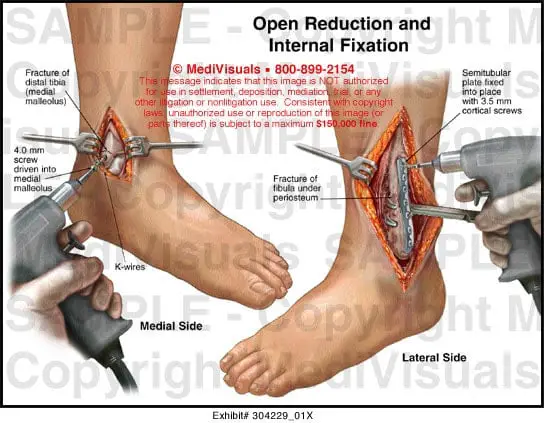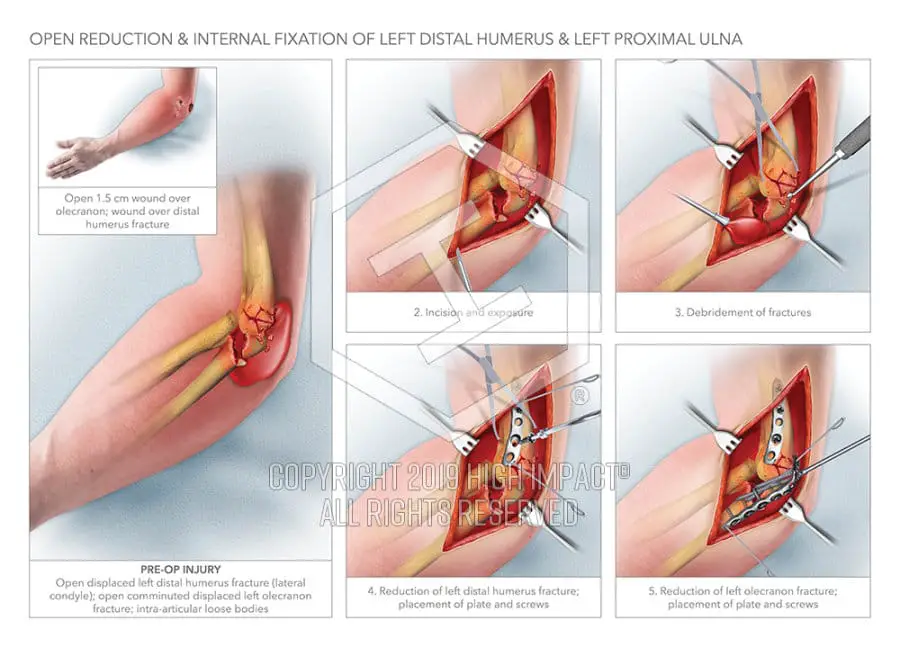Open Reduction Internal Fixation- All You Need To Know!
ORIF or open reduction internal fixation is a surgery performed to fix bones that are broken severely. It is only practiced when the fractures are so severe that they cannot be treated using a splint or cast. These injuries are mostly fractures that are unstable, displaced, or involve the joint.
“Open reduction” in open reduction internal fixation refers to the incision or cut made by the surgeons to re-align the unstable bones while “internal fixation” means that the unstable or displaced bones will be held together using hardware metal like screws, rods, pins, and plates. Once the bone completely heals, this hardware remains as such and is not removed.
Generally, Open reduction internal fixation is immediate or urgent surgery. The doctors might recommend this surgery if the bone:
- Sticks out through your epidermis or skin
- Moved out of alignment or position
- Breaks in multiple places.
- A joint dislocates
ORIF might also assist in healing the bones if they were previously re-aligned without performing an incision, called closed reduction, but did not heal completely the way they should have been.
This surgery helps reducing pain and store mobility by assisting the bones to heal in the correct position.
Despite the elevating success rate of open reduction internal fixation surgery, the recovery depends on several factors, these include health condition, severity and location of the fracture in bones, post-surgery rehabilitation, and age.
Let’s see in detail what open reduction internal fixation surgery is and how it is done.
Open reduction internal fixation surgery

This surgery is performed by an orthopedic surgeon. The operation is practiced to repair fractures in your arms or legs, including the bones inside the ankle, knee, hip, shoulder, elbow, and, wrist.
Based on the fracture and dangers of complexities in the surgery, this procedure may be performed instantly or registered in advance. If you have the surgery scheduled for later, you might have to fast for some time and hold taking several medications beforehand.
Before performing the surgery, you might even receive one of these:
- Physical examination.
- X-ray
- CT scan
- MRI scan
- Blood tests
All the tests will let the surgeon review and examine the broken bone properly.
Open reduction internal fixation is two-part surgery. The surgery may take a few hours, based on the fracture and several other factors involved.
An anesthesiologist will provide you common anesthesia. This puts you in a really deep sleep through the surgery time so you will not sense any pain. You may be fixed on a breathing tube too so that it can help you breathe correctly.
The first part of this surgical procedure is open reduction. The operator will cut your skin or create an incision and move the broken bone back into its natural position.
The next part of the surgery is internal fixation. The doctor will connect metal rods, pins, screws, or plates to the broken bone to hold the bone in its place. The kind of hardware utilized in the procedure is based on the area and which type of fracture the individual has.
Ultimately, the last step involves the surgeon closing that cut or incision made using stitches or staples, then applying a bandage, and might put the limb in a splint or cast based on the position and kind of fracture.
What to expect after open reduction internal fixation

Following the Open Reduction Internal Fixation, surgeons and nurses will observe the blood pressure, pulse, and breathing. The doctors will also review the nerves near your broken bone.
Based on the surgery, you might leave for your home that day itself or you may even stay in the clinic for one to a few days. If you are having a fracture in an arm, you might visit the house later that day. If you already have any fractures in your leg, you may be required to stay for long.
Open reduction internal fixation surgery recovery time
Commonly, the recovery takes between 3 to 12 months. All the surgery is diverse. Full recovery after the surgery depends on several factors such as the type of surgery, severity f the fracture, and location of the fracture. Restoration of the bones may take extended time if you have any complications following the surgery.
Once the bones start to heal, the surgeon may require you to perform physical or any occupational therapies.
An occupational therapist or physicist may show you some of the specific recovery exercises. These movements will assist you to regain muscle strength and action in the area for moving it normally.
For a sleek and fast recovery, here are some things you can perform at home:
- Don’t apply too much pressure- The limbs might require staying motionless or immobile for a while. If you were provided a sling, crutches, or wheelchair utilize them as instructed by the surgeon or physicist.
- Continue your physical therapy- If the physical therapist explained to you about home activities and stretches, make sure you perform them regularly.
- Make sure the incision made remains clean. Keep it wrapped and wash your hands very often. Ask the surgeon how to correctly replace the bandage once it has been long with one bandage.
- Lift your limb. After Open Reduction Internal Fixation, your surgeon might ask you to raise the limb and implement ice to reduce swelling.
- Take the given pain medication. You may require to take some over-the-counter medicines or prescription pain medication or maybe both at times. Follow the doctor’s instructions carefully.
It’s essential to revisit all your checkups following surgery. This will allow your surgeon to monitor the healing process.
Walking after an Open reduction internal fixation surgery
Following Open Reduction Internal Fixation ankle surgery, you will not be capable of walking for some time.
You can always go for a knee scooter, crutches, or seated scooter. Staying off the ankle will limit complications in the procedure performed and support the bone and cut made to heal.
The surgeon will guide you when you can implement weight to your ankle. This time will differ from fracture to fracture and person to person based on several factors given above including age.
Risk and side effects of ORIF

Similar to all other surgeries, even this surgery might have some side effects and potential risks associated with it. These side effects include the following:
- Audible snapping and popping.
- chronic pain as a result of hardware
- compartment syndrome occurs when there is an extended pressure in your arm or leg.
- Arthritis
- Tendonitis
- the metal hardware inserted might start moving out of place
- lessened or lost mobility
- muscle spasms or injury
- allergic reaction at times to anesthesia given.
- nerve damage or blood vessel damage
- tendon damage or ligament damage
- incomplete healing or abnormal bone healing
- Bleeding
- blood clots
- Bacterial infection, either due to the incision made or hardware inserted after the surgery.
If the hardware inserted gets infected, it may require to be removed. You might also want to redo the surgery if your fracture does not heal correctly.
These difficulties are rare. However, you are more prone to develop difficulties if you smoke or have any medical ailments such as:
- Diabetes
- obesity
- history of blood clots
- rheumatoid arthritis
- liver diseases
To restrict your possibilities of complications, understand and follow your doctor’s guidance before and after the surgery takes place.
Ideal Candidates For Open Reduction Internal Fixation
Know that this surgery is not meant for everyone. You might be a suitable candidate for ORIF surgery if you have a severe fracture that cannot be cured or handled with the help of a cast or splint, or if a person has already had another closed reduction but they did not benefit and the bone did not fix correctly.
You do not need ORIF surgery if you have any minor fractures, knee pain, or dislocations. Your surgeon may be able to handle the break using a closed reduction or with the help of a cast or splint.
When should you call a doctor?
- High fever over the body temperature 101.5°F or 38.5°C.
- Skin feels very irritated or growing sores, particularly near the edges of the cast placed within the broken bone in the body.
- Fingers or your toes start turning very cold, swollen, pale, or, blue.
- Pain that cannot be controlled by the medication doctors has prescribed you.
Pros and cons of Oral reduction internal fixation surgery

Pros
- ORIF surgery possesses a remarkably high success rate.
- After completing the surgery usually, people return to regular daily activities once their recovery is completed.
- It may avoid the necessity for a prolonged time in plaster. For several complex injuries, it gives the best potential outcomes and is needed above and past plaster treatment for the bones.
Cons
- Disadvantages or setbacks of Open Reduction Internal Fixation may involve infection, slight swelling, and mobility of the hardware installed within the broken bone.
- The healing or recovery process might take a few months as bones grow gradually.
- Other factors that might influence recovery are the location of the fracture and its severity, the age of the sufferer, and the kind of bone broken.
After Open Reduction Internal Fixation ankle surgery, the patient would not be ready to take steps normally for a few days. One may however utilize crutches Without applying too much pressure on their ankle to limit complications and assist the bone and incision made to heal faster. Your surgeon will guide you when you can start applying weight to the ankle. The time alters for each fracture.
The Bottom Line
If you are having a severe fracture, the surgeon might suggest open reduction internal fixation surgery. An orthopedic surgeon makes an incision on the skin, re-positions your broken or displaced bone, and then holds it collectively using metal hardware like pins, plates, or screws. ORIF is not for minor fractures that mostly can be improved with the help of a cast or splint.
ORIF restoration can last for as long as 3 months to 12 months. You will require physical therapy or occupational therapy, rest, and pain medication.
You must reach your doctor if you encounter bleeding, an increase in the pain, or dissimilar new signs or symptoms through the recovery process.

